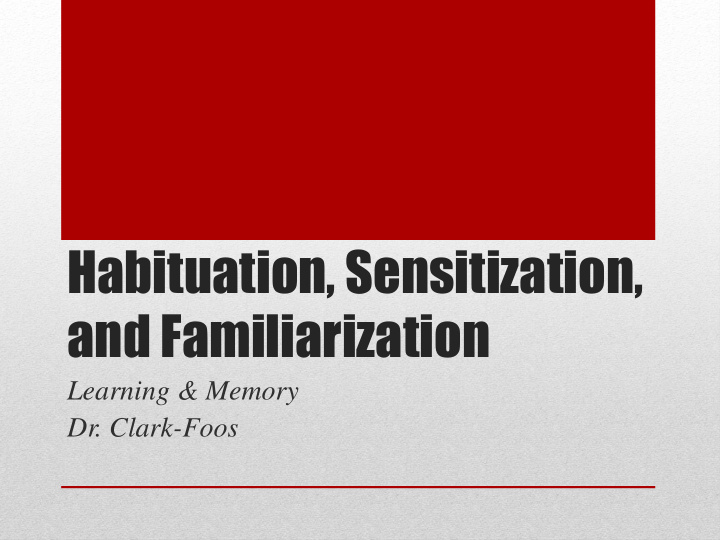



Habituation, Sensitization, and Familiarization Learning & Memory Dr. Clark-Foos
Habituation the ability to ignore irrelevant, repetitive stimuli • What else are you habituated to right now ? • My first experience with snow
Where does habituation occur? • The case of the simple reflex (3 neurons) http://www.motordevelopment.net/media/2011/04/reflex-arc.jpg Non-Learning Explanations 1. Decreases in sensitivity of sensory receptor ( adaptation ) 2. Fatigue of motor response
Where does habituation occur? • The case of the reflex Sensory 1. Decreases in sensitivity of sensory receptor ( adaptation ) Neuron? 1. Habituate jumping reflex to loud sound. 2. Play sound in a new location. 3. Observe dishabituation or reorienting to new location. * Alternatively, observe other (non-habituated) behaviors. 2. Decreases in the responsiveness of motor neuron or muscle Muscle? ( fatigue ) 1. Habituate jumping reflex to loud sound. 2. Play new sound or new stimulus. 3. Observe dishabituation/spontaneous recovery.
• A brief video demonstrating habituation of an acoustic startle reflex in a rat. https://www.youtube.com/watch?v=Kfu0FAAu-10 • Other measures: orienting responses, fixation time, etc. • Not always advantageous • e.g., Deer and gamblers
Utility of Habituation: Recognition Memory • Novelty preference/ preferential viewing • Length and content of memory • Rats & Monkeys look 2x as long at novel stimuli
• Stimulus Specificity and Generalization • Dishabituation • Coolidge Effect • “Ha. Tell that to [Mr./ Mrs ] Coolidge.”
Influences on Habituation • Interstimulus Interval (ISI) • Short-term and Long-term Habituation • Massed Exposure • Faster habituation in short-term • Spaced Exposure • Longer habituation, less spontaneous recovery
Sensitization heightened awareness/responsiveness to a stimulus or class of stimuli for a period of time. • Can you think of other things you have been sensitized to?
Habituation vs. Sensitization
Sensitization • Dishabituation and Sensitization • Fear-potentiated startle reflex • Desensitization • Skin conductance response (SCR) • Prepulse inhibition • Quiet tone Startling Tone Less response • Less response, Habituation • Not Stimulus Specific, Sensitization
Dual Process Theory • Sensitization and Habituation, at the SAME time. • Behavior is result of summation Opponent Process Theory • Take the good with the bad.
Experience-based learning Object Recognition • Neophobia • Dolphins Familiarity • “sense of sameness” (James, 1890) • Priming, word-stem completion task • Moth detection in blue jays (Bond & Kamil, 1999)
• Recognition of Individuals? Johnston (1993): Flank scent memory in golden hamsters • Habituation to Hamster A’s scent can last up to 30 min. Hamster A Hamster B flank scent flank scent
• More Golden Hamsters Can they distinguish between two female hamsters with similar scents?
Perceptual Learning increased ability to detect and classify particular sensory stimuli after exposure • Chicken Sexers • Coke vs. Pepsi • Rats in Fancy Houses learn faster* (Gibson & Walk, 1956) • Mere Exposure (Gibson & Gibson, 1955) • Other-race effect (Malpass & Kravitz, 1969) and improvement
Spatial Learning Memory for turns, Visual Cues Messing with Wasps (Tinbergen & Kruyt, 1972)
• Biology of Habituation: Why Sea Snails? Aplysia (invertebrates) are simple, with large unique neurons • Gill/siphon withdrawal reflex
• Kandel’s Aplysia research (e.g., Squire & Kandel, 1999) • Habituation of a gill withdrawal reflex • Repeated stimulation results in long-lasting (long-term memory?) habituation for several weeks. • Synaptic Depression (dual process theory)
• Kandel’s Aplysia research (e.g., Squire & Kandel, 1999) • Neuronal mechanism of habituation glutamate
• Kandel’s Aplysia research (e.g., Squire & Kandel, 1999) • Neuronal mechanism of habituation • Sensory-Motor Synapse • Sensory neurons still fire AP • Motor neurons still sensitive to neurotransmitter, just less of it. • Homosynaptic • Fewer synaptic connections and fewer vesicles being released presynaptically • Crayfish and cats
• Kandel’s Aplysia research (e.g., Squire & Kandel, 1999) • Neuronal mechanism of sensitization • Electric shock to tail results in sensitization of gill withdrawal
• Kandel’s Aplysia research (e.g., Squire & Kandel, 1999) • Neuronal mechanism of sensitization • Modulatory Interneurons (heterosynaptic)
• Kandel’s Aplysia research (e.g., Squire & Kandel, 1999) • Neuronal mechanism of sensitization • Ionotropic vs. Metabotropic receptors 1. Modulatory interneuron releases serotonin 2. Presynaptic K+ channel blocked, Action Potential prolonged 3. CA++ channels open, more Ca++ in presynaptic 4. More Ca++ docking with vesicles, more neurotransmitter 5. More neurotransmitter, more AP from motor neuron
Perceptual Learning and Cortical Plasticity • Somatosensory cortex • Receptive Fields • Topographic map • Development • Blind kittens and opossums • Specific and multimodal and new? • Exposure
Spatial Memory • Hippocampus size and importance • Place cells (O’Keefe & Dostrovsky, 1971) • Nobel Prize in 2014 • Shrinkage or blocking, decreased abilities
Damage and Rehabilitation after Stroke • Use it or Lose it and Learned non-use • Constraint-induced movement therapy • Possibly a form of perceptual learning
Human-Machine Interfaces • Cochlear implants • Rats with night vision
Recommend
More recommend